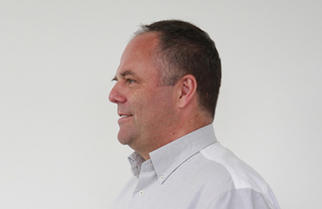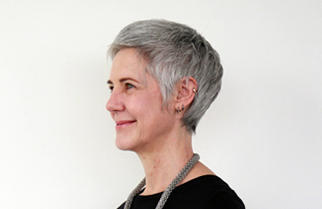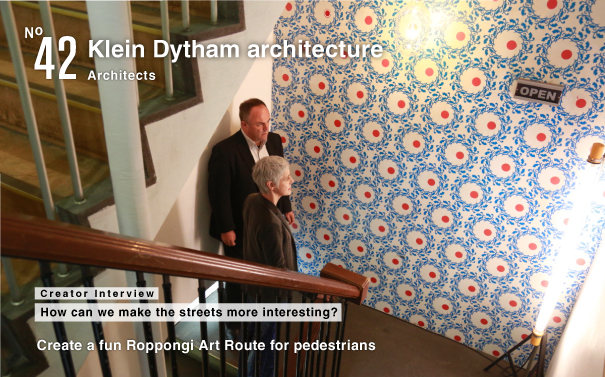
42 Klein Dytham architecture (Architects)
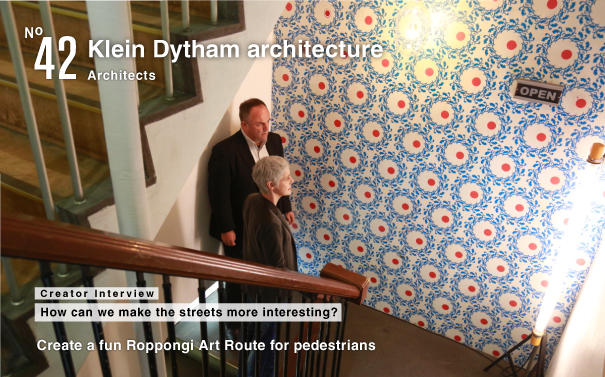
Astrid Klein (below in photo) and Mark Dytham (above in photo) were the guests for the creator interview of the "Roppongi Future Talks" held in front of an audience at the Roppongi Art Night 2014. The architects have designed the Daikayama T-Site and the Google Japan office, and are also known for starting the presentation event "PechaKucha Night" which has now spread to 750 cities. They have been in Japan for 25 years. For the interview, they put on the "furusato" (hometown) badges which were being distributed that day. Note: the text below is not a transcript but a translation of the interview held in Japanese.

Memories of Roppongi
KleinI'm putting the Eurasia badge on my shoulder. My parents are German. I was born and raised in Italy, went to universities in France and Britain and came to Japan in 1988. Dytham is British.
DythamWe came here 25 years ago. It all started when we came across books like "Shinkenchiku (New architecture)" and "GA JAPAN" at the university library. Of course, the books were all written in Japanese, but they were fascinating and made us want to come to Japan.
KleinCities like London, Paris and Rome are conservative and don't have much room for new things. But we saw that in Japan, there were really bold, unexpected architecture. We thought, "They built this! They have such buildings! Unbelievable!" and we felt we had to see for ourselves.
DythamIn those pre-Internet days, it wasn't easy to plan our visit to Japan. Now it's so much easier. Although I'm still struggling a bit with the Japanese language...(laughs) I'm trying.
KleinWe were very lucky to be able to work at Toyo Ito-san's architectural firm. We learned so much there. I feel that we are here today thanks to Ito-san.
DythamIn those days, when you heard the name "Roppongi", you would think of ...well, the Defense Agency building. (laughs) There was this very long wall and beside it was a tiny rock bar - a most peculiar establishment.
KleinWe were young, so we would come to Roppongi to have fun late into the night, or rather, until early morning. I remember very clearly that we had a hard time catching taxis beneath the elevated highway. The taxi drivers wouldn't stop for foreigners because of the language barrier. So we would be standing waiting in the wind, very cold and tired. Ropppongi was a fun place, but memories of getting home are not so pleasant.
DythamIt was the bubble era, so on a Friday night, it was impossible to get a taxi. Back then, AXIS was about the only place in Roppongi that had design and art. Now we have Roppongi Art Night. It's astonishing how Roppongi has been transformed into an area of design and art.
KleinIt has become an increasingly appealing, attractive place, during both the daytime and nighttime. I hope Roppongi keeps evolving as a place of entertainment.
SAKURA CAFE, the Google Japan office, the Youtube studio
DythamWe've been given opportunities to do all kinds of projects in Roppongi. One example is the SAKURA CAFÉ on the Grass Square of Tokyo Midtown. We did that project six years ago.
KleinThe bench and the high tables were shaped like cherry-blossom petals; you could sit on them to relax and drink tea. We wanted to make the cherry-blossom viewing season even pinker.
DythamAnd it looked really lovely at night with the illumination.
KleinWhen the tables were removed, we had land art because there were different colored patches on the ground. The ground had changed color - in other words, the lawn had been damaged, and the people at Tokyo Midtown had complaints about that. (laughs)
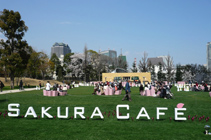
SAKURA CAFE
A limited-period open-air café setup in 2008 to mark the first anniversary of Tokyo Midtown. It was open from March 29 to April 13, and offered refreshments themed on "sakura" cherry blossoms.
DythamWe also designed the Google Japan office in Roppongi Hills and the YouTube creator studio. Since the floor plan is huge and there are four floors, it's difficult to remember which floor you are on. So we tried to make navigation easier by putting up wallpapers in the same colors as the Google logo.
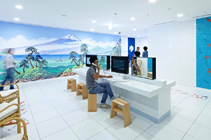
Google Japan office
Google's office in Tokyo located on the upper floors of the Roppongi Hills Mori Tower. Equipped with a ping-pong table, music room, and bar, it has attracted attention for its unique design incorporating Japanese details such as traditionally patterned wallpaper.
KleinGoogle has offices all over the world. Since this is the office in Japan, we wanted to create an interior that had hints of Japan. So we included features such as a "sento" (bath house) and a "yatai" (food stall) - though of course, they are not real - as well as a room with tatami mats.
From "Deluxe" to "SuperDeluxe"
KleinOur ties to Roppongi go back a long way. Our office used to be right near the shopping district of Azabu-Juban. It was named "Deluxe" and was like what is now called a "shared space". We called it Deluxe because it was spacious. Its interior was like a warehouse though, and not at all deluxe. (laughs) The large space allowed us to hold all kind of events. We shared the space with five companies. One of them was a beer company called "Tokyo Ale", and so we also held events to drink their beer.
DythamOur slogan was "Thinking and drinking".
KleinEventually, the number of events increased and began to conflict with our work. We then set up a new space on the Roppongi Dori before construction of Roppongi Hills was completed.
DythamThe space in Azabu Juban is "Deluxe" and the one in Roppongi is "SuperDeluxe." The latter is bigger and has capacity for around 250 people. It opened during the Tokyo Designers Week of 2002, so it's been 12 years.
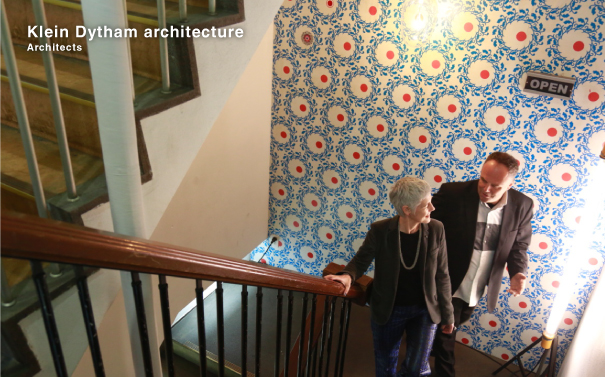
The spread of PechaKucha Night to 750 cities around the world
KleinWe work as architects, but that is our day job; Super Deluxe is our night job. (laughs) Holding events is interesting because you get to meet lots of people, but you need to have a proper business plan and offer something every day. We wondered what kind of event would draw people on weekdays like Tuesdays or Wednesdays, and we came up with "Pecha Kucha Night".
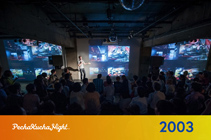
PechaKucha Night
A presentation event thought up by Astrid Klein and Mark Dytham. The first event was held in February 2003 at SuperDeluxe and later spread to other countries - mainly in Europe. Videos of more than 2,000 presentations can be viewed online.
http://www.pechakucha.org/
DythamThe concept of Pecha Kucha is "Show and tell". Many architects like to talk, and if asked to do a normal presentation, they will go on and on, using numerous PowerPoint slides. So to make it compact, we devised a format of showing 20 images, each for 20 seconds. The limit is 6 minutes 40 seconds. When the time is up, it's over - it's like a "design karaoke." (laughs)
KleinThe good thing is that anyone can participate - young people, older people. You can talk about anything as long as it's about something creative like your personal project or your current obsession, or maybe an interesting trip you made. It's like a casual communication between friends. This event has now spread from Roppongi to 750 cities around the world.
DythamIn this month (April 2014) alone, a total of 138 events were held around the world. It's popular because the format can be used by anyone and it's free. We realize now that we made a big mistake 10 years ago. (laughs)
KleinIt's a pity [that we made it free]. (laughs) A famous person can hold exhibitions and lectures and get magazine interviews. But when young people make things, they have no place to present them. At a PechaKucha event, all you need are 20 photos and a little episode, and you can easily make a presentation.
DythamWhether a well-known person or a student, everyone goes on the same stage. The students make smooth presentations because they've practiced a lot beforehand. Famous architects who are used to talking with a lot of slides tend to be more nervous.
An art route between Tokyo Midtown and Roppongi Hills
DythamOh yes, we have come today with an idea for the future of Roppongi. We suggest making a "Roppongi Art Route" in the backstreets connecting Tokyo Midtown, the National Art Center, Tokyo and Roppongi Hills. Tokyo Midtown is lovely, the National Art Center is lovely, and Roppongi Hills is lovely, but the streets in between ...leave a lot to be desired.
KleinPerhaps you could say that the streets are too "kirei" (clean). There's nothing to see while you are walking. The streets lack appeal and don't make people want to walk on them.
DythamWhen you've been to the 21_21 DESIGN SIGHT or the National Art Center, and the next thing you want to see is, for example, the Andy Warhol exhibition at Roppongi Hills, this is the only route you can take. But it's such an uninteresting route. Something should be done about it.
KleinThe facilities are so nice, so we should make an effort to enhance the spaces in between. People from all over the world come to Roppongi. More thought should be given to the streets for pedestrians.
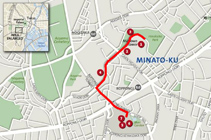
Roppongi Art Route
During this interview, Klein and Dytham proposed the following route: Midtown Garden (21_21 DESIGN SIGHT) → Tokyo Midtown Nishi Kosanten (intersection) → National Art Center, Tokyo → Roppongi Rokuchome Kosaten (intersection) → underground walkway → Roppongi Hills (Mori Art Museum)
DythamThe most famous art route in the world is the High Line in New York.
KleinThey turned what used to be a railroad into a park, and installed artworks. The Toyoko Line is being reconstructed now, but a Tokyo equivalent of the High Line would be like the Toyoko Line being preserved and turned into a road for people to walk on.
High Line
An aerial greenway in New York City. The park was developed by reusing an elevated railroad formerly used for freight trains. The old railway and railroad ties, together with the planted trees and installed artworks create a unique landscape, and the park is attracting attention as a new spot of scenic beauty.
http://www.thehighline.org/
Plants in the streets for improving the landscape
KleinSo we should think about how to make this route more pleasant for walking. The first thing to consider is plants. When a building is built, the landscape ordinance now requires a certain percentage of land to be used for plants. But in many cases, it's just some trees planted here and there, and it's not very inspiring. I think greenery should be encouraged to grow more toward the roads. The Midtown Garden here is very pleasant, isn't it?
DythamWe designed the temporary enclosure for Omotesando Hills during its construction. We didn't want to make just an ordinary wall. We tried to make it interesting by creating a wall covered with fresh greenery.
KleinWe also made a façade evoking a bamboo forest for the accessory shop acrylic opposite the Arisugawanomiya Memorial Park. The shop is on a tiny plot of land, but we imagined how it would look if there was a park there. The shop opened during Tanabata (Star Festival) and so we gave out "tanzaku" (small pieces of paper) to the customers and to the people in the streets.

Temporary enclosure for Omotesando Hills
A screen covered with greenery dubbed "Green Green Screen" set up as a temporary enclosure for Omotesando Hills during its construction from 2003 to 2005. Around 10 different types of plants such as ivy and rosemary were installed in vertical panels on the 274 meter-long screen.
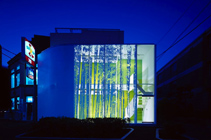
acrylic
A jewelry shop opened in 2005 for Masako Bando's "acrylic" brand. An image of a bamboo grove adorns the shop's glass façade.

An art ordinance for placing art in the streets
KleinThe second thing needed in enhancing the streets is to establish an art ordinance - just as there is a landscape ordinance. It would be interesting if there were rules that said, "Artwork must be installed here." Such steps will heighten people's consciousness.
DythamThey've been removed now, but we once installed tree-shaped display cases in front of Laforet Harajuku. That kind of project is what we have in mind for the Roppongi Art Route.
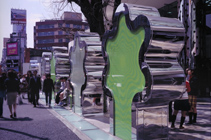
Laforet Harajuku display cases
"Tree monument" display cases placed at the entrance of Laforet Harajuku. The cases could be used as showcases or light boxes for graphic work.
KleinIt's like window-dressing. Instead of just placing products in a row, a storefront can be made to look a bit like an art gallery by collaborating with arti sts.
DythamAnd we want to give more opportunities to young artists and designers. Of course, the artists don't need to be famous - they could be students. The windows of a real estate agency are usually covered with advertisements and don't look enticing. But if there was information about real estate at the top, and there were artworks hidden below, people passing by could search for the art, and it would like art treasure hunting.
KleinLike "Where's Wally?" (laughs) Another idea would be to create guerilla art on the noticeboards and signboards in the streets.
DythamWe could also have painting on pedestrian crossings. Perhaps the kind of adhesives used for floor advertisements in stations could be used for artwork on the roads. And maybe the 100-yen parking lots could be rented for displaying art.
KleinThe fences of parking lots are dull, so we could ask students to do something interesting with them. During this year's Roppongi Art Night, they collected old clothes and made a huge skirt. Maybe old clothes could be woven and made into a wall piece.
DythamAlso, the highway in Roppongi is.. a problem. It's quite dirty and dark.
KleinIt doesn't make people feel happy or excited. It's somewhat scary, isn't it? Many steps have been taken to improve the area around the Roppongi intersection, but [not the highway itself]. The highway is huge and makes its presence felt, so we should make it nicer. How about placing a mirror on the sides or the bottom of the highway to reflect the surrounding landscape? Then it would glitter like the sunlight on the surface of water. Water doesn't flow in the expressway, but there is a flow of cars. If its surfaces had mirrors, the expressway wouldn't look so imposing.
Getting scolded for making uninteresting things
KleinWe envision roads and the expressway that are fun and surprising. We want streets where people can look at art and experience things - have an adventure while walking. People don't linger when the streets are not interesting. Even in places where there are no cafés, people would stay if there were chairs and benches. For the people operating the establishments, the bigger crowds and garbage might be a nuisance, but in the long run, they would benefit from treating the passersby as customers, and thinking about the needs of customers. Perhaps the shops and restaurants might experience some inconvenience, but I'm sure they would be rewarded tenfold.
DythamInstead of just thinking about connecting point A, point B and point C, we should think about connecting the spaces in between. I must add though, that compared to the past, Roppongi has become more interesting. As for this art route, we could first concentrate on the route itself, and gradually expand, making improvements on other streets, parks, police stations and so on.
KleinThere are many regulations and movements aimed at keeping the streets nice but usually the rules are too strict and forbidding. It's like "You mustn't do this, you mustn't do that." But the opposite approach needs to be taken - people should be scolded when they are not making interesting things. The criticism should be "This isn't interesting, that isn't interesting." The spirit should be "Let's do away with all things dull!"
Working toward the same goal for change
KleinNo town is perfect; every town has its problems. But the important thing is to come up with ideas to improve things, and to take action. People need to start by doing what they can do, however small the step maybe. We mustn't expect too much from administrative authorities because then projects are delayed and budgets don't get approved. (laughs)
Roppongi was not an area of design and art in the past, but these days, some kind of event related to design and art is held every week, and it's taken for granted now, isn't it?
DythamI also feel that it's these tiny seeds that are important. PechaKucha Night was a small event which has now spread all over the world. If you sow the seeds, then you can eventually do bigger things. The Olympics will be held in Tokyo soon, so we now have a great opportunity.
KleinPeople, including myself, tend to dislike change. There's a sort of hesitancy. In our work as architects, there are times when a bureaucrat tells us, "This is fine by me, but I'm not sure about my boss." To that, we always respond, "In that case, please let us talk with your boss!" And then we do our very best in explaining and persuading. We point out that we are all human and that every one of us is a nice individual, and that there's no benefit in hiding behind rules. We do what is called "nemawashi" (preparatory talking to gain support) in Japanese. (laughs)
DythamWe went through that process when we designed the Daikanyama T-Site. After that building was built, the town underwent a considerable transformation. It was quite remarkable.
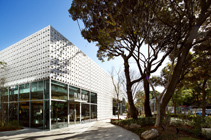
Daikanyama T-Site
A commercial complex opened in 2012 on the Kyu-Yamate-dori street whose main feature is the Tsutaya bookstore. The outer walls are decorated with the letter "T" motif. The complex consists of three buildings each offering products in different genres. Customers can browse books, DVDs and CDs while drinking coffee.
KleinOf course, it wasn't due to our efforts alone, but due to the cooperation made by a large number of people. When people cooperate in that way, moving toward the same goal, change becomes possible.
Editor's thoughts
Klein-san and Dytham-san had brought images to show us, and we held the interview while looking at the pictures projected on the screen. It felt like being at a PechaKucha Night event. Klein-san told us that they came up with the idea of "not doing anything that is not interesting" when they opened SuperDeluxe. You can read more about that here. (Japanese version only)(edit_kentaro inoue)




